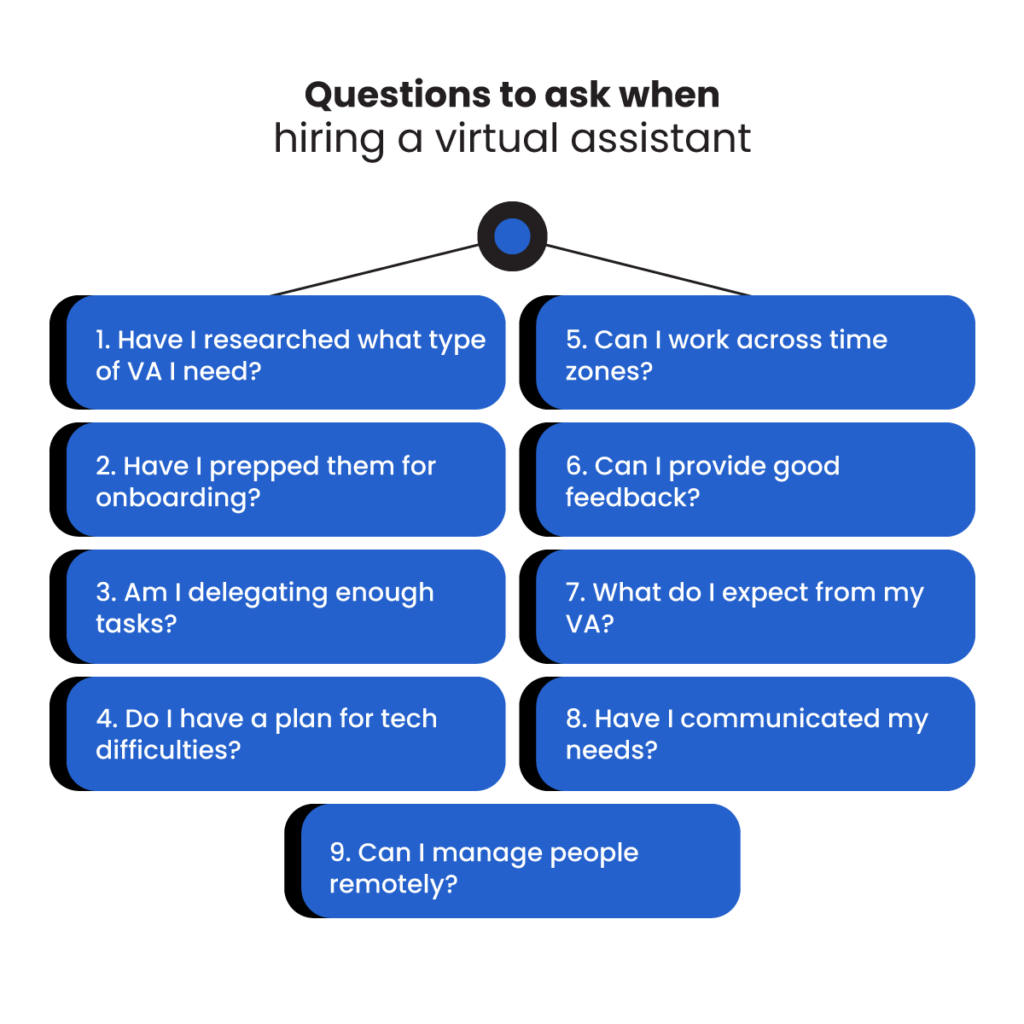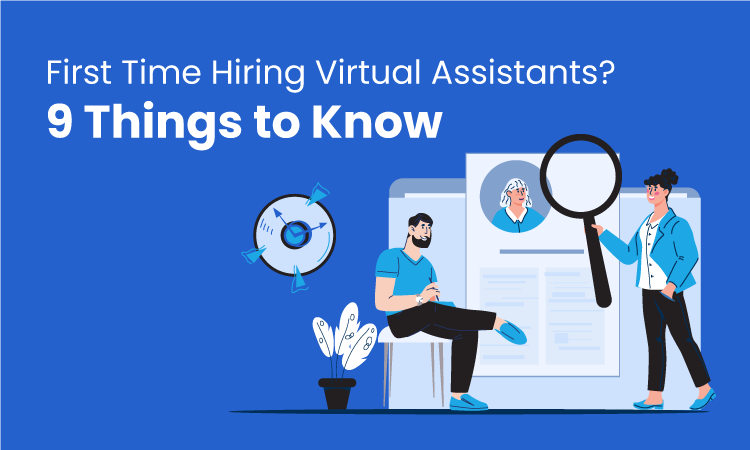Today, it’s pretty common for business owners to have a VA or virtual assistant. Having a remote worker, even a part-time one, saves employers approximately $11,000 per year. But if you’ve never worked with a VA before, you might wonder how to get the most out of the arrangement. Don’t worry; hiring virtual assistants does take a lot of legwork and preparation.
We got you covered, though! By reading through the challenges on this list and conducting your own research, you will be ready to onboard your first virtual assistant and begin a successful working relationship. We’ll also show why Wing, with its dedicated, trained remote assistants, is your best choice for creating productivity where it really counts for your business. Let’s jump in: here are 9 things you should know about hiring a VA for the first time.

1. Hiring virtual assistants requires research
There are plenty of considerations to make when hiring a VA, so you will want to conduct research first. The first thing to consider is the employment arrangement. Depending on your budget and timelines, you might opt for a freelancer or a managed service.
Freelancers can be more flexible but also less reliable. A reputable managed service costs more, but you can be sure you’ll get a pre-vetted, quality VA. You’d also want to consider what tasks you need your VA to do. Your team might need a virtual assistant with a set of skills specific to your business or you might be looking for one to complete basic administrative tasks.
It’s also a good idea to research reviews to ensure that your remote assistant has universally desirable soft skills like diligence, attention to detail, and adaptability.
Here is a list of a few qualities that you should look for when conducting research and vetting a remote assistant:
- Time management
- Proactiveness
- Adaptability
- Reliability
- Organization
Wing pre-vets all our VAs for these skills and more. New hires then undergo a rigorous training program to build up skills in social media marketing and basic graphic design tasks. Working in tandem with other VAs on a team overseen by an experienced operations manager, Wing remote assistants can hit the ground running and make meaningful contributions to your team on day one.
2. You must prepare a lot of things for onboarding
A well-trained virtual assistant will have experience working with other businesses and learning many tasks quickly. This can be a major asset, but they will need your direct guidance and input to put these skills to good use.
Every company is different. Needs and expectations may differ as well. It’s important to set these expectations early to make sure that there is no confusion. Since you know your business best, the more detailed information you can provide to your VA ahead of time, the better.
Here are a few things you might want to provide to a VA for onboarding purposes:
- Workflows
- Daily schedule
- List of internal contacts
- Employee training manual
- Detailed product information
- Company background information
- Passwords/Log on Information for systems
- Detailed protocol guidelines (e.g. how to answer phones)
This is not an exhaustive list, but hopefully it gets the ball rolling and helps you brainstorm assets that would be helpful for your remote personal assistant on day one. Whenever possible, you should provide this information in writing so your VA can reference it while on the job. These assets will also be useful if you hire additional VAs in the future.
3. Hiring virtual assistants means learning to delegate
Even the most seasoned managers may have issues delegating tasks to a virtual assistant who is new to the team. After all, how can you be sure your virtual assistant will complete the assigned task in a timely fashion?
Delegation is one of the cornerstones of effective management. When hiring virtual assistants, you need to have an established system in place for delegating the right tasks to your virtual assistant.
Here are a few tasks that a well-trained virtual assistant should be able to complete:
- Basic SEO
- Data entry
- Scheduling
- Web research
- Phone support
- Content writing
- Social media posts
- Basic graphic design
- Email inbox management
- Inventory and supply ordering
Wing VAs use a task queue to do unlimited work on all these tasks and more. Simply add your tasks to the queue in order of priority and your Wing remote assistant will work through them. They also use workflows: drag and drop tasks to complete a simple flowchart that explains processes in plain English.
Wing will take care of completing workflows for you if you’re too busy. And if you need things done more quickly, you can opt for the Pro plan, which offers two dedicated assistants for twice the productivity.
4. You must prepare for technical hiccups
The important thing to consider when using technology in the workplace is to have a solid backup plan for when things do go wrong. Technical hiccups are a part of the modern workplace. Servers can go down, connections can fail, and websites can crash. Plan to connect via email if Slack crashes or have text contact information handy in the event of a server outage.
Wing offers a variety of technical options for communicating with your remote assistant, including call, text, Slack message or via a mobile app. What’s more, clients have a Customer Success Manager who acts as a liaison and helps them get the most out of the service. You can set up a customized backup plan in the event of a technical outage and rest assured that your assistant will still be getting work done in the event of unforeseen circumstances.
It is completely understandable that hiring managers have misgivings about hiring remote assistants who will be dependent on technology to complete tasks. But the solution is not to hope this doesn’t happen, but plan for what your team will do when it does.
5. Hiring virtual assistants means working across time zones
Another issue that managers frequently consider when hiring virtual assistants is time zone differences. How can a virtual assistant be truly successful if he or she is working in a different time zone?
The truth is, working with a VA in a different time zone can be an asset, not a liability. Imagine waking up in the morning to a managed calendar and email inbox. Or imagine finishing work for the day, confident in the knowledge that your virtual assistant will craft social media posts and publish them by the beginning of work tomorrow.
With a Wing basic plan, you’ll get a committed remote assistant who is fluent in English for 8 hours a day, 5 days a week. These highly skilled VAs can get things done anywhere on the planet, and you can access Wing services from anywhere in the world too. You can choose any 8-hour window that works best for you and automatically keep track of your hours. There is also always the option to add more time or assistants if you need.
You might want to have some overlapping time when you are working alongside your VA, then allow them to continue work on after hours tasks that don’t require your input. However you decide to use the time, a VA can be just as effective when working across time zones if you set clear goals and expectations for deliverables.
6. You must be comfortable with providing feedback
Assistants only get better at doing their job the longer they work for a client, so providing feedback – especially at the start – will help them get more value out of their assistant.
It’s a good idea to set up milestones to check in with your remote assistant. The one week, three month, and six month marks are standard times but you can adapt this however you see fit.
The point is to schedule a performance review check in ahead of time to make sure that it happens. It’s also a good idea to note areas of improvement (and areas for positive reinforcement) as you go to mention at this meeting.
An experienced Wing operations manager supervises each team of VAs. They also receive regular feedback from a quality assurance team. But your input in the process is not only appreciated, it is vital to the success of your partnership. After all, you are the best advocate for your business and its needs. With your clear feedback and the oversight of management, your Wing VA can add value where it’s needed most.
7. Hiring virtual assistants doesn’t translate directly into $$$
Just because you have a virtual assistant doesn’t mean this will boost your company’s revenue. VAs are cost-effective solutions to task management, but in the end you should only expect dedicated team members to add directly to the bottom line.
What a remote assistant will provide, however, is more time and bandwidth. What you do with that added free time is up to you. While this doesn’t translate directly into sales or revenue for your company, it will free you up to do higher level tasks like close sales deals and secure funding.
With the added time and bandwidth to focus, your team can improve every metric you care about by cutting out distractions and focusing on what team members should be doing.
8. You must set communication guidelines
In a virtual work environment with a remote assistant who may be in a different time zone, employers often worry about communication. Will you be able to reach your remote assistant in a timely manner? And how do you know if your VA is “on the clock” or not?
The easiest way to alleviate this confusion is to take the lead and establish clear communications guidelines up top. For starters, you’ll need to align with your remote assistant on when his or her “office hours” are. This helps you manage the amount of tasks you expect from them every workday and when you can expect deliverables. Also, you need to establish what tools you’ll use when communicating instructions.
Once you decide on an 8-hour window for your virtual assistant services, you can reach your Wing VA whenever you need. Wing remote assistants have a 3-minute response time and are available by call or text during office hours. You can also use the Wing mobile app or add them to your Slack groups.
9. Hiring virtual assistants requires you to be a manager
If you are hiring your first virtual assistant, it can be difficult negotiating how to supervise in a remote environment. Although many workplaces have shifted online, some managers have concerns about whether they can effectively monitor a remote assistant who is not there in person.
Think of hiring a remote assistant as an opportunity for you to flex your management muscles. This means holding employees accountable for goals, following through with points for improvement, and reinforcing a job well done.
If you’re hiring virtual assistants from platforms like Upwork, you will have to be a bit more hands-on with management. Wing VAs, on the other hand, work in teams with guidance from an onsite manager, so they never have to figure tasks out on their own.
Hiring virtual assistants takes time
It isn’t easy finding a good assistant, and it’s even more challenging to find a good virtual one. Hopefully, this article will help you identify things you should know before hiring. We’ve also distilled the information above into questions. You could use these to evaluate your readiness to hire an assistant:
Wing is your source for quality virtual assistants
Hiring virtual assistants isn’t easy, but Wing makes the process as smooth as possible with managed, trained, dedicated assistants at $899 a month for up to 3 user accounts.
Assistants can complete a variety of common administrative tasks and learn specialized VA skills in industries like real estate and Amazon e-commerce. With a 3-minute response time and availability via call, text, via mobile app, or Slack, Wing offers options for whatever your business needs. Schedule a call or chat with us to start right away.
Dan Eder writes frequently about digital marketing trends, SaaS, and e-commerce. He has previously worked as a content writer at an SEO agency for tech companies, an e-commerce specialist at a Fortune 500 company, and a journalist for several educational outlets. Read more from him at www.daneder.com.







